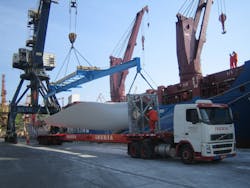Hosting the 2016 Olympic Games and the World Cup of Soccer in 2014 means Brazil definitely has some wind in its sails. And what better to harness that wind than a forest of wind farms?
Located in Natal, Rio Grande do Norte, the consulting engineering firm of Próxima Engenharia has its offices on the doorstep of some of the most active wind turbine projects in the country. They are actively involved in constructing wind energy sites across Brazil and specialize in design work for highways, land developments and wind-tower parks. They have also designed wind-tower projects in Spain and Poland.
There are wind energy companies from all over the world who are trying to get a foothold in the rapidly expanding Brazilian power generation market. Próxima Engenharia leveraged its location close to the projects and its years of experience to become influential in the marketplace.
“We have designed several wind farms in Rio Grande do Norte, Paraíba, Ceará, Bahia and Rio de Janeiro,” said Fernando Cesar de Oliveira Furtado, chief executive officer of Próxima Engenharia. “We feel in the northeastern states of Brazil have the greatest wind potential in the country. In the southern part of Brazil, we have the state of Rio Grande do Sul with great potential as well.”
In Brazil, some of the wind farm locations are quite remote, and the roads are not always perfect ribbons of smooth asphalt. In northeast Brazil, the majority of wind farms are in the coastal regions, and many are made of sand-dune soil. Some of the bridges the special transport trucks have to traverse are only rated for loads up to 36 tons, and specialized equipment like the nacelles weigh much more. The truck drivers also have to deal with oncoming traffic and navigating narrow roads.
“In the coastal region, the wind farms are near federal or state highways,” said Furtado. “In the mountains, there is a greater shortage of major roads, so there are situations where we need to build access roads of 10 to 15 km in length.” Alegria 1, located on the sand dunes of Guamaré was easy to get to, while the Santa Clara wind farm, near the town of Parazinho, was just past 11 km off a main road.
He continued, “Our roads do not have enough lane width, and our highway interchanges often aren’t designed for such large combinations as the truck and trailer. These combinations need special permission to travel and also need leader cars to facilitate efficient movement throughout the trajectory of the turns. In the beginning, most of the difficulties encountered were in designing internal accesses inside the farms, especially areas of maneuvers. But in these cases we relied on AutoTURN heavily in order to facilitate these projects,” said Furtado.
Johns is with Transoft Solutions.



